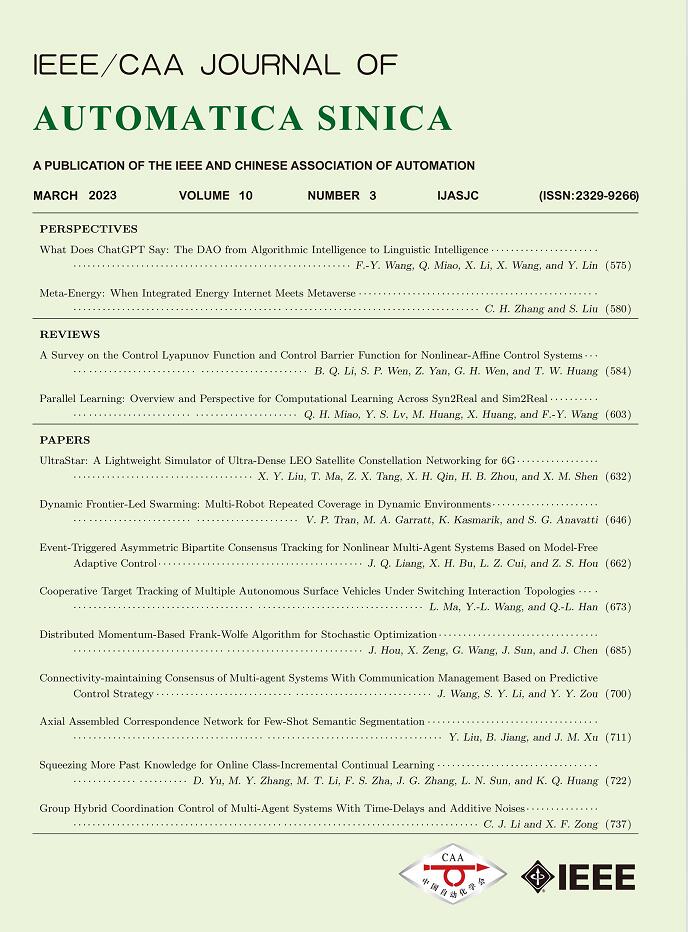 Volume 10
Issue 3
Volume 10
Issue 3
IEEE/CAA Journal of Automatica Sinica
| Citation: | X. Liang, W. W. Yan, Y. S. Fu, and H. H. Shao, “Process monitoring based on temporal feature agglomeration and enhancement,” IEEE/CAA J. Autom. Sinica, vol. 10, no. 3, pp. 825–827, Mar. 2023. doi: 10.1109/JAS.2023.123114 |

| [1] |
M. Nawaz, A. S. Maulud, et al., “Review of multiscale methods for process monitoring with an emphasis on applications in chemical process systems,” IEEE Access, vol. 10, pp. 49708–49724, 2022. doi: 10.1109/ACCESS.2022.3171907
|
| [2] |
S. A. A. Taqvi, H. Zabiri, et al., “A review on data-driven learning approaches for fault detection and diagnosis in chemical processes,” ChemBioEng Reviews, vol. 8, no. 3, pp. 239–259, 2021. doi: 10.1002/cben.202000027
|
| [3] |
W. Ku, R. H. Storer, et al., “Disturbance detection and isolation by dynamic principal component analysis,” Chemometrics and Intelligent Lab. Syst., vol. 30, no. 1, pp. 179–196, 1995. doi: 10.1016/0169-7439(95)00076-3
|
| [4] |
Y. Li, X. Xiu, et al., “Towards efficient process monitoring using spatiotemporal PCA,” IEEE Trans. Circuits Systems II: Express Briefs, vol. 70, no. 2, pp. 551–555, 2023. doi: 10.1109/TCSII.2022.3171205
|
| [5] |
S. Kiakojoori and K. Khorasani, “Dynamic neural networks for gas turbine engine degradation prediction, health monitoring and prognosis,” Neural Computing and Applications, vol. 27, no. 8, pp. 2157–2192, 2016. doi: 10.1007/s00521-015-1990-0
|
| [6] |
M. A. Kramer and B. L. Palowitch Jr, “A rule-based approach to fault diagnosis using the signed directed graph,” AIChE J., vol. 33, no. 7, pp. 1067–1078, 1987. doi: 10.1002/aic.690330703
|
| [7] |
X. Zhou, T. Tian, et al., “Research on transformer fault diagnosis technology based on adaboost-decision tree and DGA,” in Proc. 16th Annual Conf. China Electrotechnical Society, 2022, pp. 1179–1189.
|
| [8] |
C. Dong and J. Zhou, “A new algorithm of cubic dynamic uncertain causality graph for speeding up temporal causality inference in fault diagnosis,” IEEE Trans. Reliability, 2022.
|
| [9] |
L. Saidi, J. B. Ali, et al., “Application of higher order spectral features and support vector machines for bearing faults classification,” ISA Trans., vol. 54, pp. 193–206, 2015. doi: 10.1016/j.isatra.2014.08.007
|
| [10] |
A. Vaswani, N. Shazeer, et al. “Attention is all you need,” in Proc. Advances Neural Information Processing Systems, Long Beach, USA, 2017, pp.5998–6008.
|
| [11] |
T. Chen, S. Kornblith, et al., “A simple framework for contrastive learning of visual representations,” in Proc. Int. Conf. Machine Learning, 2020, pp. 1597–1607.
|
| [12] |
P. Khosla, P. Teterwak, et al., “Supervised contrastive learning,” Advances in Neural Information Processing Systems, vol. 33, pp. 18661–18673, 2020.
|
| [13] |
H. Wu and J. Zhao, “Deep convolutional neural network model based chemical process fault diagnosis,” Computers &Chemical Engineering, vol. 115, pp. 185–197, 2018.
|